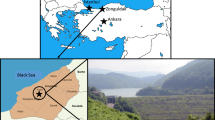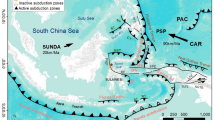Abstract
The variation characteristics of dynamic stress in crustal blocks and its relationship with earthquakes are comprehensively studied by analyzing geophysical data and calculating the dynamic response of crustal blocks in North China to the tide level change of Bohai Sea and Yellow Sea using a 3D nonlinear dynamic finite element simulation. This study has noticed some new features of crustal dynamic stress: (a) High stress level appears at the place where the stress waves superpose and interference during the process of propagation, and the enhancement of dynamic shear stress is more significant as compared with that of compressive stress; (b) Variation of dynamic stress has influence on seismogenic environment and hence earthquake occurrence; (c) As viewed from the variation characteristics of crustal dynamic stress, the superimposing process of shear stress manifests the preparation process of earthquakes.
Similar content being viewed by others
References
Brodsky E E, Karakostas V, Kanamori H. 2000. A new observation of dynamically triggered regional seismicity: Earthquakes in Greece following the August, 1999 Izmit, Turkey earthquake [J]. Geophys Res Lett, 27: 2741–2744.
Byerlee J. 1993. Model for episodic flow of high pressure water in fault zones before earthquakes [J]. Geology, 21: 303–306.
CHEN Bing, JIANG Zai-sen, CHE Shi et al. 2003. Study of triggering action between Mani (M S7.9) and Kunlun (M S8.1) great earthquakes and their dynamic background [J]. Earthquake Research in China, 19(1): 1–7 (in Chinese).
Department of Earthquake Disaster Prevention, China Seismological Bureau. 1999. Earthquake Catalogue of Modern Times in China (A.D. 1912–1990, M S≥4.7) [M]. Beijing: China Science and Technology Publishing Press, 443–629 (in Chinese).
FU Zheng-xiang, LIU Gui-ping, CHEN Qi-fu. 2001. Dynamic analysis on interaction between the Haiyuan-Gulang-Changma great earthquake in the north boundary of the Tibetan plateau [J]. Seismology and Geology, 23(1): 35–42 (in Chinese).
Gomberg J. 2001. The failure of earthquake failure models [J]. J Geophys Res, 106(B8): 16253–16263.
Harris R A. 1998. Introduction to special session: Stress triggers, stress shadows, and implications for seismic hazard [J]. J Geophys Res, 103: 24347–24358.
Harris R A, Simpson R W. 1992. Changes in static stress on southern California fault after the 1992 Landers earthquake [J]. Nature, 360: 251–254.
HE Zhen, WANG Cheng, NIU An-fu et al. 2000. Preliminary research on emulating the dynamic evolution of crustal stress-strain and deformation [J]. Crustal Deformation and Earthquake, 20(1): 1–7 (in Chinese).
Hill D P, Reasenberg P A, Michael A et al. 1993. Seismicity remotely triggered by the magnitude 7.3 Landers, California, earthquake [J]. Science, 260: 1617–1623.
Institute of Seismology, State Seismological Bureau. 1989. The Collection of Satellite Images of Main Action Fault Zones in China [M]. Beijing: Science Press, 86–101 (in Chinese).
Kilb D, Gomberg J, Bodin P. 2000. Earthquake triggering by dynamic stresses [J]. Nature, 408: 570–574.
LU Ming-wan and LUO Xue-fu. 1990. Basic Theory of Elasticity [M]. Beijing: Qinghua University Press, 410–415 (in Chinese).
LU Ming-yong. 1994. Analysis, Amendment of Seismogenic Models and Study on Them in Fracture Mechanics [D]: [MS Thesis]. Whhan: Institute of Seismology, state Seismological Bureau, 10–13 (in Chinese).
LU Ming-yong, NIU An-fu, ZHOU Zheng-rong. 2003. Discussion on spatio-temporal evolutionary characteristics of faulting activity in the middle-short period of strong earthquake [J]. Earthquake, 23(4): 1–9 (in Chinese).
Mohanmad R. 2000. Remote earthquake triggering along the Dead Sea fault in Syria following the 1995 Gulf of Aqaba earthquake (M S=7.3) [J]. Seis Res Lett, 71: 42–52.
Okada Y. 1992. Internal deformation due to shear and tensile faults in a half-space [J]. Bull Seism Soc Amer, 82: 1018–1040.
Vidale J E, Agnew D, Johnston M et al. 1998. Absence of earthquake correlation with each tides: An indication of high preseismic fault stress rate [J]. J Geophys Res, 103(B10): 24567–24572.
WANG Shuang-xu, JIANG Zai-sen. 1997. Dynamic evolution and abnormal character of deformation field before Lijiang M S7.0 and Tangshan M S7.8 earthquakes [J]. Crustal Deformation and Earthquake, 17(4): 40–45 (in Chinese).
ZHENG Wen-heng, WANG Cheng, HE Zhen et al. 2002. Response of crust to ocean tide [J]. Journal of Geodesy and Geodynamics, 22(2): 41–46 (in Chinese).
Author information
Authors and Affiliations
Additional information
Foundation item: National Natural Science Foundation of China (40174024).
About this article
Cite this article
Lu, My., Zheng, Wh. Preliminary study on variation characteristics of ocean tide dynamic stress in crust and its relationship with earthquakes. Acta Seimol. Sin. 18, 303–312 (2005). https://doi.org/10.1007/s11589-005-0079-8
Received:
Revised:
Accepted:
Issue Date:
DOI: https://doi.org/10.1007/s11589-005-0079-8




